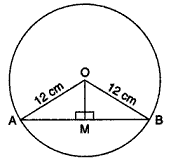Ask questions which are clear, concise and easy to understand.
Ask QuestionPosted by Aman Satija 4 years ago
- 5 answers
Anmol Preet 4 years ago
Sanchita Pandey 4 years ago
Posted by Aalim Malik 4 years ago
- 0 answers
Posted by Ankita Patel 4 years ago
- 1 answers
Sia ? 4 years ago

r = 12 cm, {tex}\theta{/tex} = 120o
{tex}\therefore{/tex} Area of the corresponding sector of the circle = {tex}\frac\theta{360^\circ}\mathrm{πr}^2\;=\;\frac{\displaystyle120}{\displaystyle360^\circ}\times3.14\;\times12\times12\;{/tex}= 150.72 cm2
Area of {tex}\triangle{/tex}AOB
Draw OM {tex}\perp{/tex} AB
In right triangle OMA and OMB,
OA = OB ....... Radii of the same circle
OM = OM ........ Common side
{tex}\therefore{/tex} {tex}\triangle{/tex}OMA {tex}\cong{/tex} {tex}\triangle{/tex}OMB ........RHS congruence criterion
{tex}\therefore{/tex} AM = BM ....... CPCT
{tex}\Rightarrow{/tex} AM = BM = {tex}\frac 12{/tex}AB
and {tex}\angle{/tex}AOM = {tex}\angle{/tex}BOM [CPCT]
{tex}\Rightarrow{/tex} {tex}\angle{/tex}AOM = {tex}\angle{/tex}BOM = {tex}\frac 12{/tex}{tex}\angle{/tex}AOB
= {tex}\frac 12{/tex} {tex}\times{/tex} 120o = 60o
{tex}\therefore{/tex} In right triangle OMA,
cos60o = {tex}\frac {OM}{OA}{/tex}
{tex}\Rightarrow{/tex} {tex}\frac 12{/tex}= {tex}\frac {OM}{12}{/tex}
{tex}\Rightarrow{/tex} OM = 6 cm
sin60o = {tex}\frac {AM}{OA}{/tex}
{tex}\Rightarrow{/tex} {tex}\frac{\sqrt3}2{/tex}= {tex}\frac {AM}{12}{/tex}
{tex}\Rightarrow{/tex} AM = 6{tex}\sqrt3{/tex} cm
{tex}\Rightarrow{/tex} 2AM = 12{tex}\sqrt3{/tex} cm
{tex}\Rightarrow{/tex} AB =12{tex}\sqrt3{/tex} cm
{tex}\therefore{/tex} Area of {tex}\triangle{/tex}AOB ={tex}\frac 12{/tex} {tex}\times{/tex} AB {tex}\times{/tex} OM
= {tex}\frac 12{/tex} {tex}\times{/tex} 12{tex}\sqrt3{/tex} {tex}\times{/tex} 6 = 36{tex}\sqrt3{/tex} cm2
= 36 {tex}\times{/tex} 1.73 cm2 = 62.28 cm2
So, Area of the corresponding segment of the circle = Area of the correspoding sector of circle - Area of {tex}\triangle{/tex}AOB
= 150.72 - 62.28 = 88.44 cm2
Posted by Sameer Var 4 years ago
- 1 answers
Posted by Ziya Saifi 4 years ago
- 4 answers
Posted by Saloni 10A 4 years ago
- 3 answers
Posted by Minakshi Dhillon 4 years ago
- 5 answers
Posted by Lokesh Lokesh 4 years ago
- 1 answers
Lokesh Lokesh 4 years ago
Posted by Akash Buttar 4 years ago
- 2 answers
Durga Sharan Jha 4 years ago
Posted by Sai Ram 4 years ago
- 1 answers
Posted by Nitin Rao 4 years ago
- 0 answers
Posted by Rashmika Singh ?? 4 years ago
- 3 answers
Shreyans Jain 4 years ago
Posted by Satyam Sharma 4 years ago
- 4 answers
Posted by Ikra Rangoonwala 4 years ago
- 2 answers
Posted by Taniya Dandriyal 4 years ago
- 1 answers
Sia ? 4 years ago
Let the height of the building is BC, the height of the transmission tower which is fixed at the top of the building be AB.
D is the point on the ground from where the angles of elevation of the bottom B and the top A of the transmission tower AB are 45° and 60° respectively.
The distance of the point of observation D from the base of the building C is CD.
Combined height of the building and tower = AC = AB + BC
Trigonometric ratio involving sides AC, BC, CD, and ∠D (45° and 60°) is tan θ.
In ΔBCD,
tan 45° = BC/CD
1 = 20/CD
CD = 20
In ΔACD,
tan 60° = AC/CD
√3 = AC/20
AC = 20√3
Height of the tower, AB = AC - BC
AB = 20√3 - 20 m
= 20 (√3 - 1) m
Posted by Shreya Singh 4 years ago
- 3 answers
Someshwar . M 4 years ago
Dhairya Sharma? 4 years ago
Bhupendra Singh 4 years ago
Posted by Anuj Kumar 4 years ago
- 4 answers
Posted by Bhuvanraj Rajesh 4 years ago
- 0 answers
Posted by Harshit Darji 4 years ago
- 3 answers
Posted by Vaibhav Sahu 4 years ago
- 2 answers
Priya . 4 years ago
Posted by Komal Kabdal 4 years ago
- 2 answers
Md Aftab Alam 4 years ago
Posted by Mary Muannunsang 4 years ago
- 1 answers
Abhi Shek 4 years ago

myCBSEguide
Trusted by 1 Crore+ Students

Test Generator
Create papers online. It's FREE.

CUET Mock Tests
75,000+ questions to practice only on myCBSEguide app
 myCBSEguide
myCBSEguide
Anshpreet Kaur 4 years ago
0Thank You